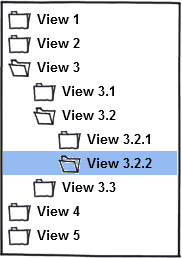

With possibly tenth of thousands of features it is obvious that these features need to be organized in some way. Views and the view structure provide a extremely flexible way to organize huge amount of features in a way that is best suited to your needs.
The view tree is a hierarchical structure of views. A view can have a parent view and subordinate views. Views without a parent view are called root views. The depth of the view tree is not limited. The view path is the path you have to go to locate a specific view in the view tree beginning from a root view. Due to the tree structure there is only one unique path for each view.
A view defines its view members by specifying a filter that is applied to all features that are members of the view's parent view, or if the view is a root view to all features. Therefore the members of a specific view are evaluated by combining the filter definitions of each view along the view's path with a logical AND operation.
The result of the execution of a view is a set of features that are called the view members. The member features of a subordinate view is always a subset of the member features of its the parent view.
In the example view structure shown in Figure 1 the actual filter that defines the members of View 3.2.2 is (Filter for View 3) AND (Filter for View 3.2) AND (Filter for View 3.2.2).

Figure 1: Example of a view structure
There is only one view tree, and this view tree is basically the same for all users accessing the Application Server. However privileges and the possibility of hiding views might restrict visibility of parts of the view tree for specific or all users. Personal (subordinate) views might be added to the view structure by each user and are also only visible for this user.
In comparison to the tree structure you know from your operating system's file system the view approach of the Application Server differs fundamentally. There is no direct association between a feature and a view, only the filter defines which features are member of a view. This results in following characteristics:
•One feature can be member of any number of views
•Changing data of a feature (including comments, observations etc) might change its view membership, since view filters can be based on data of features and their observations.
•View membership can be dynamic with time. I.e. the view membership might change only because time passed.
Besides being a tool for structuring features, views are also used to assign privileges to the view members. Therefore the privileges can be as dynamic and flexible as the view membership.
